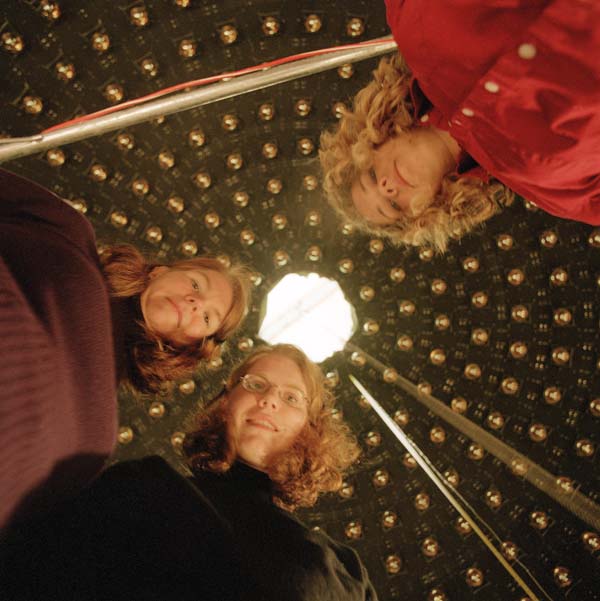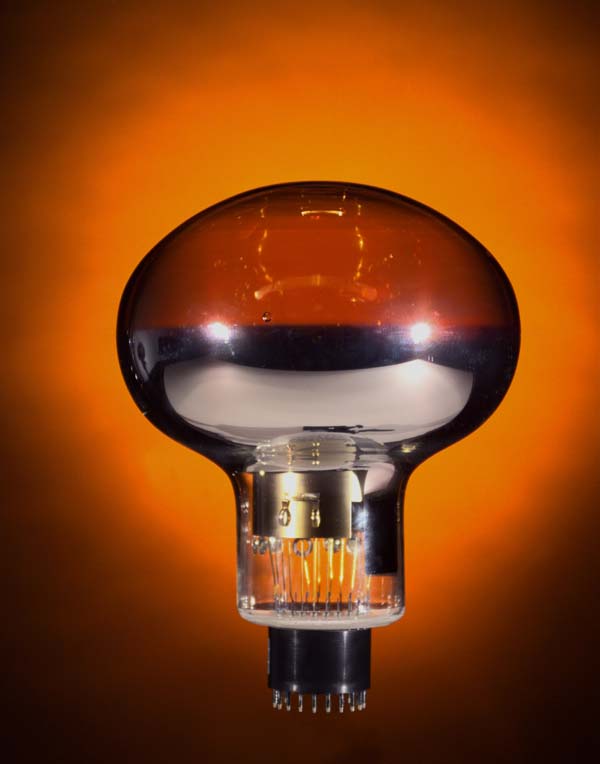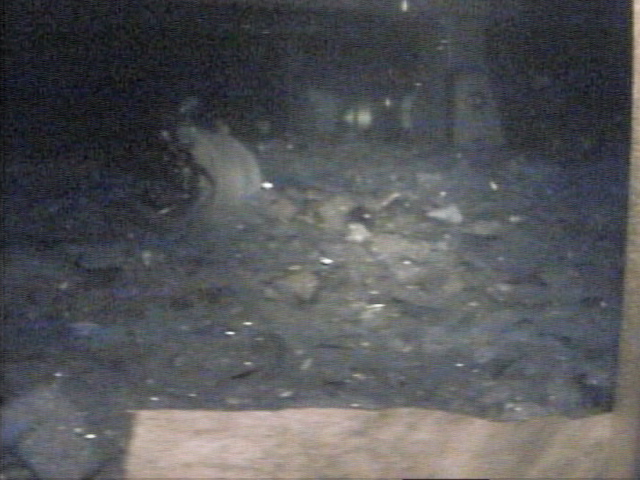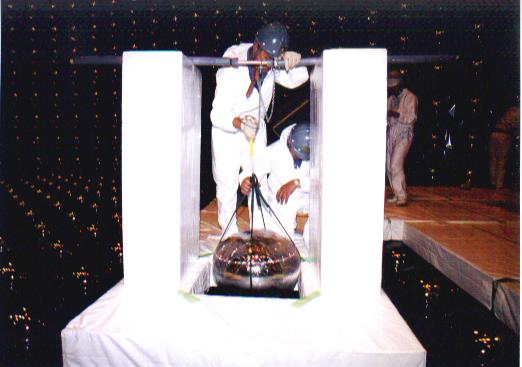 |
|
Meeting on Neutral Ground
by Pamela Zerbinos
When Rudyard Kipling penned those words in the early 1890s, he probably wasn’t thinking about physics. And that’s a good thing, because he would have been wrong. Let’s imagine that east is particle physics, and west is cosmology. One studies the incomprehensibly small, and the other the indescribably large. Despite vast differences in methodology, the goals of the two disciplines are the same — understanding the hows and whys our universe — and they occasionally find themselves in the same place. Or rather,they would if they ever compared notes on their location. But east is east.... Or is it? The lines these days are less clear. One of the flies in the east-west ointment is the neutrino, that most elusive of particles. Neutrinos are leptons, fundamental particles, and therefore squarely in the particle physics realm. But there are an awful lot of neutrinos that were produced during the Big Bang, and they account for a small chunk of the dark matter in the universe, which gets them a lot of attention from cosmologists. So who gets the neutrino? No one, yet, and that’s the rub. Neutrinos were postulated in 1930 and still the particle is in the midst of a maelstrom of mysteries, some very basic. How many kinds are there? How much mass do they have? Where do they come from? Seventy years of neutrino research have yielded some answers, but even more questions, and particle physicists and cosmologists have started to turn to each other for new ways to find the answers. The alliance has not always been a popular one — accelerators and detectors and telescopes are expensive, and whenever that kind of money is involved, politics inevitably rears its head. But in a year when half of the Nobel Prize in Physics went to two neutrino guys for “pioneering contributions to astrophysics,” it is becoming increasingly clear that the partnership is only likely to get stronger. Fermilab’s Theoretical Astrophysics group, hoping to build that partnership and facilitate communication between the two disciplines, recently hosted “NuCosmo-02: Workshop on Neutrino News from the Lab and the Cosmos.” The three-day conference, which was attended by more than 100 scientists, ran from Oct. 17 –19 and focused on ways “to increase the dialogue between cosmologists and particle experimentalists,” said Fermilab’s Nicole Bell, who, with Kev Abazajian, was one of the main conference organizers. Both study neutrinos in the early universe.“[The fields are ]often after the same thing,” Bell said,“but they are very different and it was not until relatively recently that you could study neutrino mass by doing things like counting galaxies.”
Another of the workshop organizers, Fermilab’s John Beacom, admitted to being a bit worried that “the particle guys would show up for half the talks and then leave when the cosmologists came in. But that didn’t happen. Everyone went to all the talks.” They didn’t even sit on separate sides of the room. The star of the conference turned out to be the MiniBooNE experiment at Fermilab, which began collecting data in August and announced its first neutrino event on September 9. The main goal of MiniBooNE is to decisively close the book on the neutrino mystery that has been driving physicists craziest: LSND. In 1995, scientists working on the Liquid Scintillator Neutrino Detector experiment at Los Alamos shocked the particle physics world by reporting evidence for the transformation of muon antineutrinos into electron antineutrinos. The transformation of particles from one type into another, strange as it sounds, is actually an accepted physical phenomenon — quarks do it, and recently other neutrino experiments have shown that neutrinos, too, regularly oscillate. Despite this, the LSND results don’t mesh with those of the other neutrino oscillation experiments. If their results are confirmed and MiniBooNE sees an oscillation signal, it will require turning the Standard Model of particle physics on its head and writing in a fourth, sterile neutrino. That is, one that does not interact with normal matter — at all. “Theorists have been arguing about the LSND results since they came out, but only the MiniBooNE experiment can tell us the truth,” said Beacom. “It isn’t enough to just kill the open question of whether the results are right — it needs an oaken stake through the heart.” That same sense of urgency was invoked repeatedly throughout the conference, as speaker after speaker (the majority of whom were not from Fermilab) rose and reiterated the importance of decisive MiniBooNE results. Jonathan Link, a MiniBooNE collaborator from Columbia University, outlined the collaboration’s plan to deliver those results in a few years, and went over the technical details of the experiment to satisfy the workshop participants that the experiment was well-designed and would be able to say with a very high certainty whether LSND was right.
Representatives from other important neutrino experiments also weighed into the workshop with status reports, most of them good. Super- Kamiokande, a solar and atmospheric neutrino detector at the Kamioka Observatory in Japan (and successor to the experiment that yielded Masatoshi Koshiba part of this year’s Nobel Prize), is expected to begin running in January after suffering a serious setback in November of last year when one of the detector’s photomultiplier tubes imploded. The shockwave caused by that implosion destroyed more than half of the 11,146 PMTs in the detector and could end up costing as much as $35 million. “I hate it when that happens,” said Mark Vagins, the University of California at Irvine researcher giving the report. He said it will take around three years to replace the 7,000 destroyed PMTs, which are still hand-made by Japanese glassblowers. In the meantime, Super-K II (as the post-explosion experiment is known) will be running with half as many PMTs as the original. Even so, Vagins said, scientists will be able to collect new data on atmospheric neutrinos and neutrinos from the KEK accelerator,250 kilometers away. Super-K’s neighbor, KamLAND,a reactor neutrino oscillation experiment that is the first to test the “solar neutrino problem” (discovered by Ray Davis,Jr., one of this year’s other Nobel laureates) entirely in the laboratory, also had good news to report: the collaboration expects to announce its results within the next year. KamLAND, like MiniBooNE, is a rarity in the experimental world because regardless of what its results are, they will be a big deal, Vagins said. In addition to adding to the evidence for neutrino oscillation (and therefore mass), KamLAND will be able to clue geophysicists in to the distribution of radioactive elements in the Earth’s crust. The long-baseline world,consisting of experiments such as K2K, NuMI/MINOS and CNGS, was brimming with talk of going “off-axis,” a strategy that would yield better results by getting rid of higher-energy neutrinos. A neutrino beam is several kilometers wide, and detectors situated in the middle see particles of all energies. A detector off to the side would only see lower-energy neutrinos, and would therefore be a more controlled experiment.
Some of the NuMI/MINOS collaborators, who are hoping to bring their current project online in 2005, are already hard at work with other scientists on ideas for an off-axis detector. A Letter of Intent was submitted to Fermilab’s Physics Advisory Committee, who considered the letter in June of this year.“An ongoing healthy neutrino program would be very natural given the investments in the Main Injector and the NuMI Project,” Fermilab director Michael Witherell wrote, in response to the Letter of Intent. In addition to a possible NuMI off-axis project, a Japanese next-generation long-baseline experiment, JHF, is scheduled to begin in 2007. It would be off-axis by about two degrees. Although the experiment has yet to be officially approved, Vagins, who spends most of his time in Japan, said that “decisions are being made. Money is being spent. This is going to happen. ”Koshiba’s Nobel Prize makes this even more likely, Vagins said. The cosmological side also presented several ways to study and constrain neutrino mass, all based on the idea that a universe with a massive neutrino has a different mass distribution than a universe with a massless neutrino. Some of the techniques discussed included studying the Lyman-alpha forest (the spectral lines around a quasar), and looking at galaxy clusters.
“We don ’t really know which of these techniques will turn out to be most promising,” said Scott Dodelson, who, as group leader of Fermilab’s Theoretical Astrophysics Group, had the original idea for NuCosmo. But if he had to guess, he would say gravitational weak lensing, which involves studying how the path of light is distorted by the mass distribution in the universe.
“The [weak lensing] field is really in its infancy,” Dodelson said,“and it’s very exciting.” Because the field is so young, it is still focused on measuring distortions and is not yet to the point where it is possible to study neutrino mass. However, Dodelson expects that to change within the next decade or so. “The really remarkable thing,” Beacom said,“is that there has been so much quantitative progress in both neutrino physics and cosmology that the two disciplines now depend on each other’s results, much more than ever before. ”This state of affairs is likely to continue, helped along by conferences and workshops similar to NuCosmo-02. “We got lots of positive feedback,” Bell said. “People thought it was good that a lot of the speakers were young people out in the field, not the same faces who’ve been giving the same talk for goodness-knows-how-long.” Other participants agreed. “I’ve been to a million meetings,”said Vagins,“but I’ve never been to one quite like this.”
ON THE WEB: |




